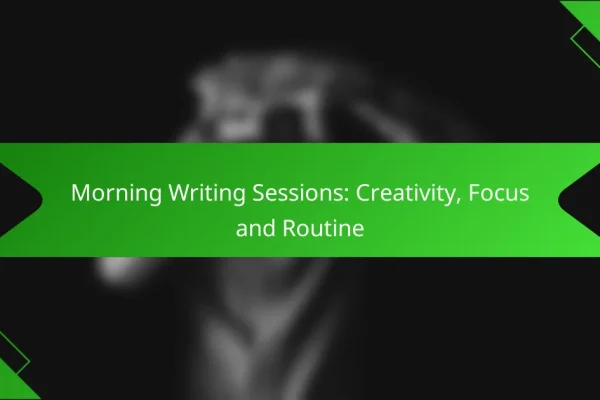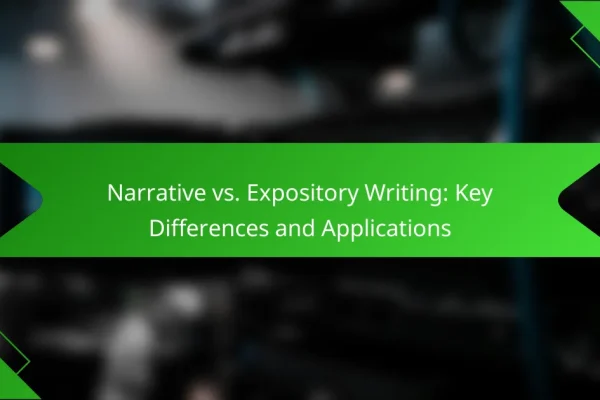
Content Creation: Resonance, Diversity and Audience Connection
Content creation plays a crucial role in enhancing audience connection by fostering engagement and building…
Mastering the art of writing requires dedication and a multifaceted approach to skill development. By practicing regularly, exploring diverse styles, and embracing feedback, you can significantly enhance your writing abilities. Key elements such as clarity, vocabulary, and grammar are essential for effective communication, while creative techniques can help unlock new ideas and overcome challenges in the writing process.

Content creation plays a crucial role in enhancing audience connection by fostering engagement and building trust through relatable material. By prioritizing diverse perspectives and understanding audience demographics, creators can craft messages that resonate deeply, making individuals feel valued and understood. This resonance not only evokes emotions but also leads to increased engagement and retention, ultimately…

Word processors like Google Docs and Microsoft Word cater to different user needs and preferences, each offering unique features. Google Docs is ideal for real-time collaboration and accessibility across devices, while Microsoft Word provides advanced formatting options and offline capabilities, making it a robust choice for detailed document creation. Which word processor is better: Google…

Understanding your target audience is crucial for crafting effective content that meets their needs and preferences. By analyzing demographics and behaviors, you can tailor your messaging to engage specific groups through personalized strategies. Additionally, measuring the effectiveness of your writing through engagement metrics and feedback ensures that your content resonates and drives desired outcomes. How…

Morning writing sessions offer a unique opportunity to enhance creativity and focus by leveraging the tranquility of early hours. By establishing a consistent routine and creating a distraction-free environment, writers can unlock fresh ideas and improve productivity. Incorporating effective tools and warm-up exercises further amplifies the benefits of this practice, making mornings an ideal time…

Narrative and expository writing serve distinct purposes in communication. While narrative writing focuses on storytelling and engaging readers through personal experiences, expository writing aims to inform or explain topics clearly and concisely. Understanding these differences is crucial for selecting the appropriate style based on your audience and intent. What are the key differences between narrative…

Editing for clarity is crucial in ensuring that your writing is easily understood and engaging for your audience. By employing techniques such as using active voice, simplifying language, and structuring content logically, you can enhance readability and convey your ideas effectively. Addressing common pitfalls like jargon and ambiguous pronouns will further improve the clarity of…

Creative writing serves as a powerful tool for engaging readers, drawing them into compelling narratives that evoke emotions and foster connections. By utilizing relatable characters, vivid imagery, and dynamic dialogue, writers can craft immersive experiences that resonate deeply with their audience. Techniques such as sensory details and imaginative metaphors further enhance this engagement, allowing readers…

Choosing the right writing style is essential for effectively communicating with your audience. By understanding their demographics and preferences, you can tailor your approach to enhance clarity and engagement. This ensures that your message resonates and fulfills its intended purpose, whether to inform, persuade, or engage. Ultimately, a clear writing style is key to ensuring…

Editing software is essential for anyone looking to enhance their video production capabilities, offering a blend of powerful features and intuitive interfaces. With options like Adobe Premiere Pro and DaVinci Resolve, users can access tools that streamline workflows and elevate project quality. By focusing on key functionalities such as multi-track editing and color correction, creators…

Incorporating regular breaks into your routine can significantly boost focus, energy, and creativity. These short pauses allow the brain to recharge, clear mental clutter, and enhance cognitive performance. By engaging in activities such as physical movement, mindfulness, or simply enjoying nature, you can foster innovative thinking and maintain productivity throughout the day. How do breaks…
Improving your writing skills involves consistent practice, exposure to various writing styles, and constructive feedback. By engaging in daily exercises, reading widely, participating in workshops, and seeking peer reviews, you can enhance your abilities effectively.
Daily writing exercises help build discipline and creativity. Set aside at least 15-30 minutes each day to write, whether it’s journaling, blogging, or free writing. This routine can help you develop a unique voice and improve your fluency.
Consider using prompts or challenges to keep your practice fresh. For example, write a short story based on a random word or describe a scene in detail. These exercises can spark new ideas and enhance your descriptive skills.
Reading a variety of genres exposes you to different writing styles, vocabularies, and perspectives. Aim to read fiction, non-fiction, poetry, and articles across various subjects. This exposure can inspire your own writing and broaden your understanding of effective techniques.
As you read, take notes on what resonates with you. Pay attention to sentence structure, character development, and narrative flow. Analyzing these elements can help you incorporate successful strategies into your own work.
Writing workshops provide structured environments for learning and improvement. Look for local or online workshops that focus on your areas of interest. These sessions often include writing prompts, discussions, and critiques, which can enhance your skills significantly.
Participating in workshops also allows you to connect with fellow writers. Networking can lead to collaborations and provide additional motivation to continue improving your craft.
Constructive feedback is crucial for growth as a writer. Share your work with peers or join writing groups to receive insights on your writing. Aim for a mix of positive and critical feedback to understand your strengths and areas for improvement.
When seeking feedback, be specific about what you want to know. Ask questions like, “Does the plot flow well?” or “Are the characters believable?” This targeted approach can lead to more useful responses and help you refine your writing effectively.
Effective writing consists of clarity, strong vocabulary, and proper grammar. These components work together to ensure that the message is communicated clearly and professionally.
Clarity in writing means expressing ideas in a straightforward manner. Avoiding jargon and overly complex sentences helps ensure that your audience understands your message without confusion.
Conciseness complements clarity by eliminating unnecessary words. Aim to convey your point in as few words as possible while retaining meaning. A good rule of thumb is to review your writing and cut out any redundant phrases or filler words.
A strong vocabulary enhances your writing by allowing you to express ideas more precisely. Using varied and appropriate words can make your writing more engaging and impactful.
However, it’s important to use vocabulary that matches your audience's understanding. Overly complex words may alienate readers, while simpler terms can make your writing more accessible. Strive for a balance that maintains interest without sacrificing comprehension.
Proper grammar and punctuation are essential for effective communication. They help convey your message accurately and maintain your credibility as a writer.
Common pitfalls include misusing commas, run-on sentences, and subject-verb agreement errors. To avoid these issues, consider using grammar-checking tools and reviewing your work carefully before publication. A well-edited piece reflects professionalism and attention to detail.
Writing techniques that enhance creativity include methods that stimulate the mind and encourage free expression. These techniques can help overcome writer's block and generate fresh ideas, making the writing process more enjoyable and productive.
Freewriting involves setting a timer for a short period, typically 10 to 20 minutes, and writing continuously without worrying about grammar or structure. This technique allows thoughts to flow freely, often leading to unexpected insights and ideas. To maximize benefits, choose a quiet space and eliminate distractions.
After a session, review your writing to identify themes or concepts worth exploring further. This practice can be done daily or weekly, depending on your schedule and writing goals.
Mind mapping is a visual brainstorming technique that helps organize thoughts and explore connections between ideas. Start with a central concept and branch out with related themes, using keywords or images. This method can clarify your thoughts and inspire new angles for your writing.
To create an effective mind map, use colors and symbols to differentiate ideas and make the map visually engaging. Digital tools or simple pen and paper can be used, depending on your preference.
Writing prompts are specific scenarios or questions designed to spark creativity and encourage new writing. They can range from simple phrases to detailed situations, providing a starting point for your work. Incorporating prompts into your writing routine can help you explore genres or styles you might not typically consider.
To find effective prompts, consider using online resources, writing groups, or books dedicated to creative writing. Set aside time each week to respond to a prompt, allowing yourself to experiment without the pressure of perfection.
Structuring different types of writing involves understanding the specific format and organization that best suits each genre. Effective writing requires clarity and coherence, which can be achieved through established frameworks tailored to the purpose of the text.
Narrative structure refers to the framework that underpins a story, typically consisting of a beginning, middle, and end. Key elements include exposition, rising action, climax, falling action, and resolution. Each part serves a distinct purpose in developing the plot and engaging the reader.
When crafting a narrative, consider pacing and character development to maintain interest. For instance, introducing conflict early can hook readers, while a satisfying resolution ties up loose ends and provides closure.
The five-paragraph essay format is a common structure for academic writing, consisting of an introduction, three body paragraphs, and a conclusion. This format helps organize thoughts clearly and presents arguments in a logical sequence. Each body paragraph should focus on a single point that supports the thesis statement.
To effectively use this format, start with a strong thesis in the introduction, followed by topic sentences in each body paragraph that relate back to the thesis. Conclude by summarizing the main points and reiterating the thesis in light of the arguments presented.
The inverted pyramid structure is essential in journalism, where the most critical information is presented first, followed by supporting details. This format caters to readers who may only skim articles, ensuring they grasp the key points quickly. The lead should answer the who, what, when, where, why, and how of the story.
When writing in this style, prioritize clarity and conciseness. Start with the most newsworthy information, then provide context and background details. Avoid jargon and keep sentences short to enhance readability, especially for online audiences.
Several tools can significantly enhance your writing skills by providing feedback on grammar, readability, and organization. Utilizing these resources can help you produce clearer and more effective written content.
Grammarly is a widely used tool that checks for grammatical errors, punctuation mistakes, and style issues in your writing. It offers real-time suggestions, making it easy to correct errors as you type.
Consider using Grammarly's premium version for advanced features like tone detection and vocabulary enhancement. This can help ensure your writing is not only correct but also engaging and appropriate for your audience.
The Hemingway Editor focuses on improving the readability of your text by highlighting complex sentences and passive voice usage. It provides a readability score that indicates the education level required to understand your writing.
To use Hemingway effectively, aim for a score that suggests a grade level of 8 or lower for general audiences. This ensures your writing is accessible and easy to follow, which is crucial for effective communication.
Scrivener is a powerful writing software designed for organizing long documents and projects. It allows you to break your writing into manageable sections, making it easier to structure your ideas and maintain focus.
When using Scrivener, take advantage of its corkboard and outlining features to visualize your project. This can help you stay organized and ensure that your writing flows logically from one section to the next.
Developing a personal writing style involves understanding your unique voice and experimenting with various techniques. It requires practice, reflection, and a willingness to adapt based on feedback and self-assessment.
Experimenting with different voices means trying out various tones and perspectives in your writing. This could include shifting from formal to conversational styles or adopting a first-person narrative versus a third-person viewpoint.
To find your voice, write short pieces in different styles. For instance, you might compose a blog post in a casual tone, then rewrite it in a more academic style. This exercise helps you identify what feels authentic and effective for your audience.
Consider the context of your writing. Different genres and audiences may require distinct voices. For example, a personal essay may benefit from a reflective tone, while a business report should maintain a professional demeanor. Keep your target audience in mind as you explore these variations.